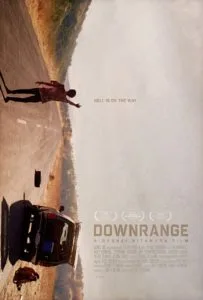Ryûhei Kitamura has had a pretty interesting and varied career. After directing his first films more than 20 years ago, the Japanese filmmaker really broke through with 2000’s action horror crossover Versus. A few years and a few movies later (2004’s Godzilla: Final Wars among them), he headed stateside. Alas, despite the kinetic energy and gleefully excessive bloodshed of 2008’s Clive Barker adaptation Midnight Meat Train and 2012 WWE production No One Lives, both films wound up box office bombs. As such, it’s no great surprise to see that Kitamura’s latest US production Downrange was clearly made on a much lower budget. Of course, a cut price approach needn’t be too great an impediment so long as the key elements are covered: a strong script, and compelling actors to bring it to life. Sadly, these are areas in which Downrange is somewhat lacking, and they rather keep the film from ever really taking off, despite a promising central idea and the odd stylistic flourish recalling the director’s earlier work.
We open on a scene that could have come directly from any horror movie since The Hills Have Eyes: a family-sized vehicle on a deserted stretch of country road suddenly gets a flat. The driver and five passengers climb out and set about changing the tyre, and as they talk among themselves we learn that very few of them know one another; they’re carpooling as they head off to their respective destinations miles away. Despite being virtual strangers, they’re all almost painfully nice to one another, very concerned about getting everyone where they need to be on time. As the men change the tyre, the women wander around trying to get signals on their phones – and, surprise surprise, they struggle to do so. Playing out more or less in real time, it’s a slow, uneventful opening, presumably designed to lull us into a false sense of security – but given we all know we’re sitting down for a horror movie, it’s more likely to leave viewers a trifle impatient. Still, while it may take the best part of 15 minutes for the shit to hit the fan, once it does it’s certainly messy: within moments of digging a bullet out of the burst tyre, more bullets burst open some members of our party. Darting to shelter on the opposite side of the car, the survivors realise to their terror that a sniper is hiding in the trees across the road, and they are trapped in the harsh sun without much food or water, and even less chance of escape.

Tone is another key problem. Kitamura’s known for his Raimi-esque energetic camerawork and self-consciously over the top gore, and while Downrange does veer in this direction during the more heightened moments, in the long lulls between it takes a far more grounded and sober approach. Again, this may have been an attempt to break with convention, keep us on our toes and take us by surprise now and then, but if so it’s not a great success. While, as established, the quiet stretches often get deathly dull, the more OTT moments stick out like a sore thumb and just feel absurd. The odd splash of black humour may raise a smile here and there, but such moments jar given it’s all played so straight elsewhere; and while it does boast stunt work that goes far beyond what you’d typically expect from an ultra-low budget movie, the lack of budget would appear to have hurt the make-up FX, with some pretty unconvincing fake blood and injury detail rather undermining attempts at harsh realism.
Were it an early feature from an up-and-comer, this might feel like a decent calling card from a director with great potential, but as the latest from a long-established filmmaker with experience working at a higher budgetary level, Downrange is a pretty big disappointment. I certainly hope this doesn’t mean we’ll never get to see Kitamura tackle anything bigger than this again, as we’ve seen before that he is capable of more.
Downrange premiered earlier this week at the Toronto International Film Festival; our thanks to the festival staff for letting us get an early look at the film.
